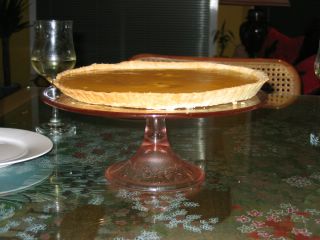I actually attempted making Seville Orange Marmalade the other day, but it didn’t work out. Stay tuned for a post on that disaster.
Tonight’s dinner, however, was the “Seville Orange Orgy” (so named by DG), and it was much more successful than the marmalade.
58. Scallops with Bitter Oranges (Basics etc.)
59. Canard à l'Orange (Basics etc.)
60. Petits Pois à la Francaise (Cooking in Advance)
61. Seville Orange Curd Tart (Weekend Lunch)
62. Shortcrust Pastry (Basics etc.)
My brother and I went to Box Hill today to pick up all the supplies, and I started cooking at around 4:30. Yes, that’s right, I started making pastry at 4:30, and the curd at 5:00pm… cutting it very very fine time-wise. Eeek.
The scallops and ducks come from the Basics etc. chapter, and are basically suggestions on how to use the seasonal Seville oranges.
For the scallops, you fry them in some butter for a minute on each side, then the corals, then deglaze the pan with Seville orange juice. Nigella says to serve them with watercress, but as watercress isn’t in the shops at the moment, I used some mixed lettuces.

Scallops with Bitter Oranges
Mmm… this was so delicious! Scallops are my favourite seafood, and I managed to find fresh ones on the half-shell today, which are so much better than frozen.
For the duck (I made two so we could have leftovers), you shove half a Seville orange in the cavity, and brush with a mixture of Seville orange juice and honey. Now, about the ducks themselves – Nigella says to use a mallard, and in fact DG warned me that I had to use the right species of duck.
“Don’t use the Peking duck duck as it’s too fatty and won’t crisp up.”
However, I don’t think our Australian butchers are quite as illustrious as the English ones, and the only ducks I could find at the poultry shop, without ordering them specially, were generic roasting ducks, species unspecified. (And I think that the ones I got were the “too fatty Peking duck” ducks). See, Nigella says 40 minutes at 210c for a duck, whereas the duck packet said something like 30 minutes per kilo plus an hour at 180c. I ended up using Nigella’s times and temperatures, but got worried about them burning before being properly cooked, and turned the heat down about halfway through. They cooked through, but weren’t very crispy.
There’s also a recipe for Petits Pois à la Francaise in Feast, which I’ve made heaps of times and absolutely love. The only problem with those peas (cooked in stock), is the resultant unpleasant “stock-breath”. However, How to Eat's Petits Pois are made stock-free. Fab! Even though you can make them a few days in advance (thus reducing the workload on the night of your dinner), I didn’t plan very well, and just made them tonight for tonight.
The ducks were really tasty, and we hacked at them hungrily with hands and knives (none of us are brilliant carvers).
Dad: ripping out a duck leg and putting it on his plate... F*#&! This is hot!
I prefer the How To Eat peas to the Feast ones. Yum. I’m so obsessed with peas right now.

Double Duck (what am I supposed to do with the neck? Do I cut it off or tuck it under?) + Petits Pois à la Francaise

Ducks from the rear
Dessert was the Seville Orange Curd Tart. FYI, for the pastry, I used half vegetable fat, half butter, because we had some vegetable fat sitting in the fridge. The pastry was flaky and light. Nigella suggests either shortcrust or sweet pastry, and I opted for the plain shortcrust. I think, though, that I'd prefer a sweeter, more biscuity pastry for this type of pie. The pastry-making process was, again, no drama. The only problem is that my flan tins are too large for Nigella’s recipes, so I’ve ended up with very thin tarts that can’t support their filling. I’ve got to go shopping for a new one, as there are quite a few tarts in How to Eat.
Making the curd is quite similar to making custard, which made me panic a little, but it wasn’t too difficult. It’s a mixture of eggs, extra yolks, sugar, Seville orange juice and zest, and butter, which you stir over a medium heat until it thickens and boils. I was being too timorous to let it boil properly, (didn’t want it to curdle) and just stopped when it got thicker. I then poured it into the pastry case, but I was worried the curd wouldn’t set, so I stashed it in the fridge until dessert time. Also, because of the thinness of the tart, I’ve got quite a bit of filling leftover, like a small bowlful… I might make a Victoria sponge or something to use up the rest.
The colour of the curd is fabulous…

Colour - very intensely orange

Tart – quite thin, and not terribly even

Gooey pie with double cream
I loved the vibrant, intense taste of the tart, but it was actually very, very sour. Perhaps my oranges were exceptionally sour or juicy. However, the tartness was offset easily, with a spoonful of double cream. I knew that double cream would be just right, because the mini lemon tarts that we serve at work have a quenelle of cream on top, and extensive taste-testing on my part has shown me that the sharpness of the filling is wonderful against the bland fatty cream.
Tonight's dinner was lovely, but definitely not something that can be whipped up for quick midweek meal. Thank goodness it's holidays now. I'm actually very tired now - 4 straight days of work, and very little sleep on Monday or Tuesday nights. After preparing that huge meal, I'm quite ready to pass out under the kitchen table.
Goodnight!


No comments:
Post a Comment